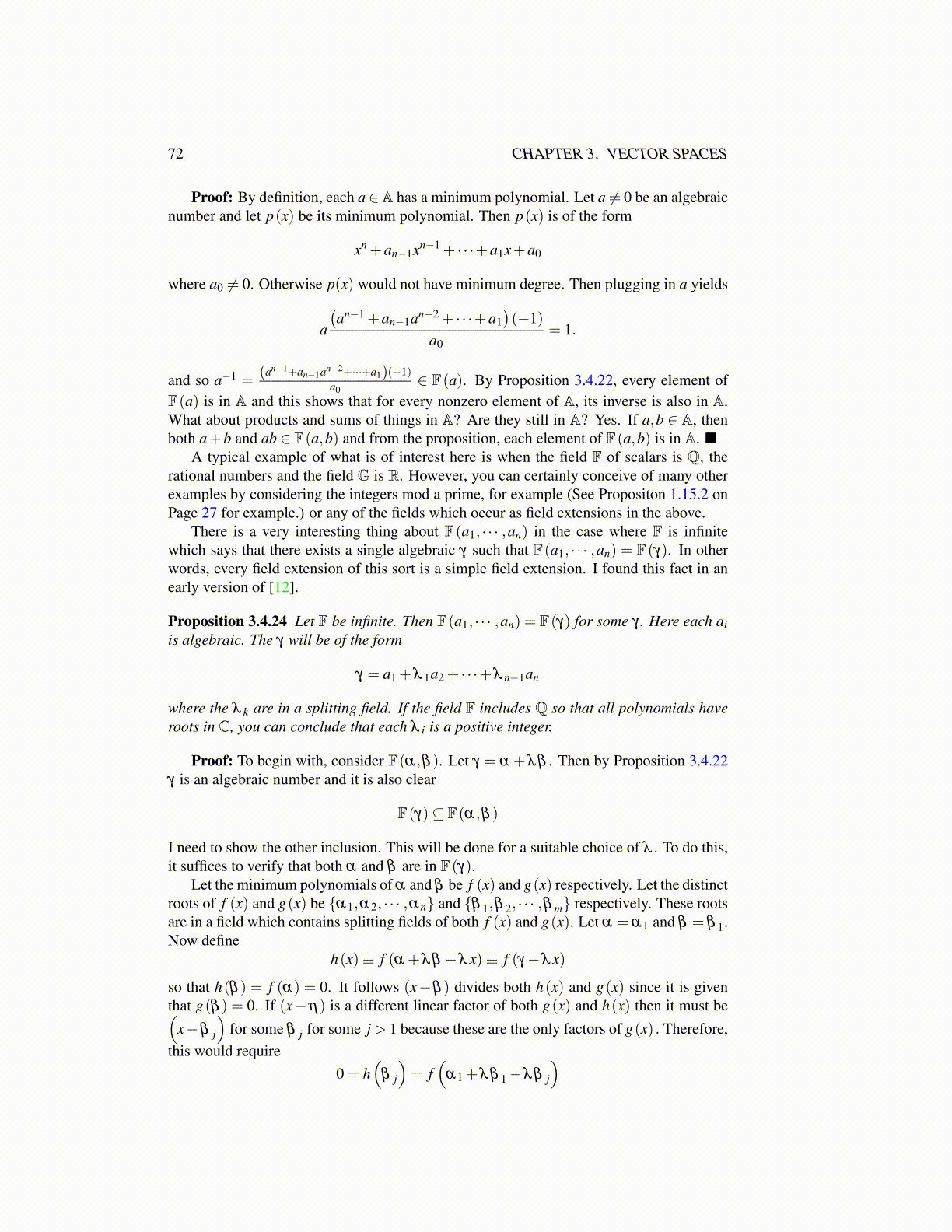
72 CHAPTER 3. VECTOR SPACES
Proof: By definition, each a∈A has a minimum polynomial. Let a ̸= 0 be an algebraicnumber and let p(x) be its minimum polynomial. Then p(x) is of the form
xn +an−1xn−1 + · · ·+a1x+a0
where a0 ̸= 0. Otherwise p(x) would not have minimum degree. Then plugging in a yields
a
(an−1 +an−1an−2 + · · ·+a1
)(−1)
a0= 1.
and so a−1 =(an−1+an−1an−2+···+a1)(−1)
a0∈ F(a). By Proposition 3.4.22, every element of
F(a) is in A and this shows that for every nonzero element of A, its inverse is also in A.What about products and sums of things in A? Are they still in A? Yes. If a,b ∈ A, thenboth a+b and ab ∈ F(a,b) and from the proposition, each element of F(a,b) is in A. ■
A typical example of what is of interest here is when the field F of scalars is Q, therational numbers and the field G is R. However, you can certainly conceive of many otherexamples by considering the integers mod a prime, for example (See Propositon 1.15.2 onPage 27 for example.) or any of the fields which occur as field extensions in the above.
There is a very interesting thing about F(a1, · · · ,an) in the case where F is infinitewhich says that there exists a single algebraic γ such that F(a1, · · · ,an) = F(γ). In otherwords, every field extension of this sort is a simple field extension. I found this fact in anearly version of [12].
Proposition 3.4.24 Let F be infinite. Then F(a1, · · · ,an) = F(γ) for some γ . Here each aiis algebraic. The γ will be of the form
γ = a1 +λ 1a2 + · · ·+λ n−1an
where the λ k are in a splitting field. If the field F includes Q so that all polynomials haveroots in C, you can conclude that each λ i is a positive integer.
Proof: To begin with, consider F(α,β ). Let γ = α +λβ . Then by Proposition 3.4.22γ is an algebraic number and it is also clear
F(γ)⊆ F(α,β )
I need to show the other inclusion. This will be done for a suitable choice of λ . To do this,it suffices to verify that both α and β are in F(γ).
Let the minimum polynomials of α and β be f (x) and g(x) respectively. Let the distinctroots of f (x) and g(x) be {α1,α2, · · · ,αn} and {β 1,β 2, · · · ,β m} respectively. These rootsare in a field which contains splitting fields of both f (x) and g(x). Let α = α1 and β = β 1.Now define
h(x)≡ f (α +λβ −λx)≡ f (γ−λx)
so that h(β ) = f (α) = 0. It follows (x−β ) divides both h(x) and g(x) since it is giventhat g(β ) = 0. If (x−η) is a different linear factor of both g(x) and h(x) then it must be(
x−β j
)for some β j for some j > 1 because these are the only factors of g(x) . Therefore,
this would require0 = h
(β j
)= f
(α1 +λβ 1−λβ j
)